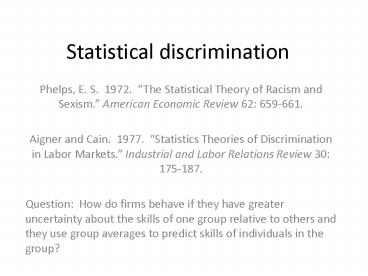Statistical discrimination - PowerPoint PPT Presentation
1 / 11
Title:
Statistical discrimination
Description:
Statistics Theories of Discrimination in Labor Markets.' Industrial and Labor Relations Review 30: 175-187. ... SELF-FULFILLING PROPHECIES ... – PowerPoint PPT presentation
Number of Views:79
Avg rating:3.0/5.0
Title: Statistical discrimination
1
Statistical discrimination
- Phelps, E. S. 1972. The Statistical Theory of
Racism and Sexism. American Economic Review 62
659-661. - Aigner and Cain. 1977. Statistics Theories of
Discrimination in Labor Markets. Industrial and
Labor Relations Review 30 175-187. - Question How do firms behave if they have
greater uncertainty about the skills of one group
relative to others and they use group averages to
predict skills of individuals in the group?
2
Notation
- y an indicator of skill such as a test score
- q true skill which the firm cannot observe
- u error term N(0,su2)
- q N(a,sq2)
- Firm wants to predict q given y. Best linear
predictor is of the form - E(qy) a by
3
Results
- a (1-?)a lt a 0lt ?lt1
- b ?
- ? (sq2 )/(sq2 su2)
- signal-to-noise ratio
- If y perfectly predicts q, su2 0 b ? 1 a
0
4
Assumption
- Majority and Minority group have
- Same average ability, a
- Same distribution of true ability, q N(a,sq2)
- Minority group has greater error variance, su2
- Implies ?W gt ?N
- (1- ?W )a lt (1- ?N )a
5
Statistical Discrimination Relationship between
test score (y) and expected skill (q)
45o
q
W
N
a
Slope ?W
Slope ?N
(1- ?N )a
(1- ?W )a
y
a
6
Results
- N workers with y lt a are predicted to have higher
q than W workers with the same test score - N workers with y gt a are predicted to have lower
q than W workers with the same test score
7
Results
- On average, N and W treated the same
- But
- high ability N will find it hard to compete for
high q jobs - If firm gains additional information on y over
time so that su2 gets smaller over time, ?N
increases in size to be closer to ?W
8
Add risk aversion parallel shift down in
relationship
45o
q
W
WR
N
NR
a
y
a
9
Add risk aversion parallel shift down in
relationship
45o
q
WR
NR
a
y
a
Now at y a, N is paid less than W
10
Hiring errors
- Type 1 False positive hire someone who is not
qualified - Type 2 False negative do not hire someone who
is qualified - Which error is more costly?
11
Self-fulfilling prophecies
- If firm assumes N is higher risk, firm may
eliminate N from the pool of top jobs - Eliminates incentive for N to acquire requisite
skills or signals to compete for top jobs































